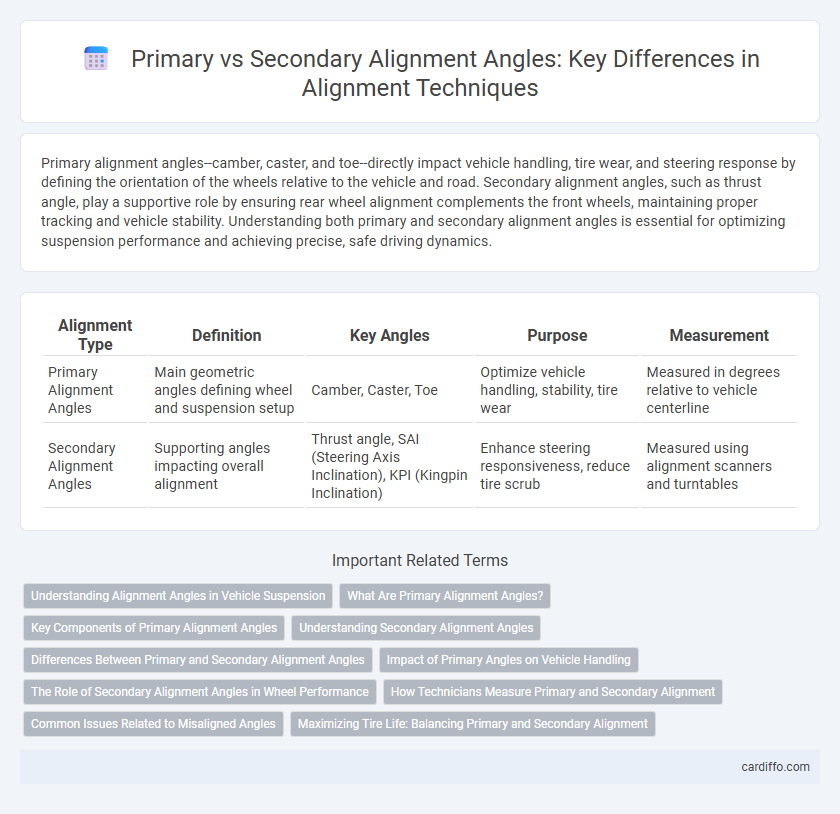Primary alignment angles--camber, caster, and toe--directly impact vehicle handling, tire wear, and steering response by defining the orientation of the wheels relative to the vehicle and road. Secondary alignment angles, such as thrust angle, play a supportive role by ensuring rear wheel alignment complements the front wheels, maintaining proper tracking and vehicle stability. Understanding both primary and secondary alignment angles is essential for optimizing suspension performance and achieving precise, safe driving dynamics.
Table of Comparison
| Alignment Type | Definition | Key Angles | Purpose | Measurement |
|---|---|---|---|---|
| Primary Alignment Angles | Main geometric angles defining wheel and suspension setup | Camber, Caster, Toe | Optimize vehicle handling, stability, tire wear | Measured in degrees relative to vehicle centerline |
| Secondary Alignment Angles | Supporting angles impacting overall alignment | Thrust angle, SAI (Steering Axis Inclination), KPI (Kingpin Inclination) | Enhance steering responsiveness, reduce tire scrub | Measured using alignment scanners and turntables |
Understanding Alignment Angles in Vehicle Suspension
Primary alignment angles, including camber, caster, and toe, directly affect tire contact and vehicle handling by ensuring optimal tire-road interaction. Secondary alignment angles, such as included angle and setback, influence overall suspension geometry and compensate for vehicle frame or axle imperfections. Understanding these angles is crucial for precise suspension tuning, improving stability, tire wear, and steering response.
What Are Primary Alignment Angles?
Primary alignment angles consist of camber, caster, and toe, and they are crucial for ensuring proper tire contact with the road, vehicle stability, and steering response. Camber adjusts the tilt of the wheels inward or outward, affecting tire wear and handling, while caster influences the steering axis and directional control. Toe controls the angle of the tires pointing inward or outward, impacting cornering performance and tire longevity.
Key Components of Primary Alignment Angles
Primary alignment angles include camber, caster, and toe, which directly influence tire contact, steering stability, and vehicle handling. Camber angle affects tire wear and grip by tilting the wheels inward or outward, while caster angle ensures directional control and steering returnability. Toe angle controls tire convergence or divergence, optimizing straight-line stability and minimizing tire scrub during turns.
Understanding Secondary Alignment Angles
Secondary alignment angles include camber, caster, and toe, which adjust the wheel's position relative to the vehicle frame and affect handling, tire wear, and stability. Unlike primary alignment angles such as thrust angle and steering axis inclination that focus on overall wheel direction and steering response, secondary angles fine-tune the suspension geometry to optimize grip and steering precision. Understanding secondary alignment angles is essential for diagnosing handling issues and ensuring optimal tire contact with the road surface.
Differences Between Primary and Secondary Alignment Angles
Primary alignment angles, including camber, caster, and toe, directly influence vehicle handling, tire wear, and steering response by defining the orientation of the wheels relative to the vehicle and road surface. Secondary alignment angles, such as included angle and setback, focus on the relationship between the wheels and the vehicle's centerline, affecting vehicle stability and tracking without directly altering individual wheel geometry. The key difference lies in primary angles controlling wheel positioning for performance and safety, while secondary angles ensure proper synchronization and overall alignment harmony.
Impact of Primary Angles on Vehicle Handling
Primary alignment angles, including camber, caster, and toe, critically influence vehicle handling by directly affecting tire contact patch, steering response, and stability. Proper adjustment of these angles ensures optimal grip, reduces tire wear, and enhances cornering precision by maintaining ideal wheel orientation during dynamic driving conditions. Incorrect primary angles can lead to understeer, oversteer, and compromised vehicle control, highlighting their importance over secondary alignment angles in handling performance.
The Role of Secondary Alignment Angles in Wheel Performance
Secondary alignment angles, including toe and thrust angle, play a critical role in wheel performance by influencing tire wear patterns and vehicle handling stability. Unlike primary alignment angles such as camber and caster, which primarily affect steering response and load distribution, secondary angles ensure that wheels track correctly relative to the vehicle's centerline, minimizing uneven tire wear and improving directional control. Precise adjustment of secondary alignment angles optimizes contact patch consistency, enhances driving safety, and extends tire life.
How Technicians Measure Primary and Secondary Alignment
Technicians measure primary alignment angles--camber, caster, and toe--using precision alignment machines equipped with laser sensors or imaging technology to ensure wheels are set according to manufacturer specifications. Secondary alignment angles, such as setback and thrust angle, are evaluated by comparing the vehicle's geometric centerline to the direction each wheel points, often using advanced diagnostic tools and computerized alignment systems. Accurate measurement of both primary and secondary alignment angles is critical for optimal vehicle handling, tire wear, and overall safety.
Common Issues Related to Misaligned Angles
Misaligned primary alignment angles such as camber, caster, and toe can cause uneven tire wear, poor steering response, and increased fuel consumption. Secondary alignment angles, including set-back, thrust angle, and included angle, often lead to vehicle pulling, steering off-center, and compromised handling stability. Regular alignment checks ensure these angles remain within manufacturer specifications, preventing costly repairs and enhancing overall driving safety.
Maximizing Tire Life: Balancing Primary and Secondary Alignment
Maximizing tire life requires precise balancing of primary alignment angles, including camber, caster, and toe, with secondary alignment angles that fine-tune wheel positioning. Ensuring optimal camber enhances tire-to-road contact, while carefully adjusted secondary angles prevent uneven tire wear and improve handling stability. A harmonized approach to both primary and secondary alignment angles extends tire longevity and promotes safer, more efficient vehicle performance.
Primary alignment angles vs Secondary alignment angles Infographic

 cardiffo.com
cardiffo.com